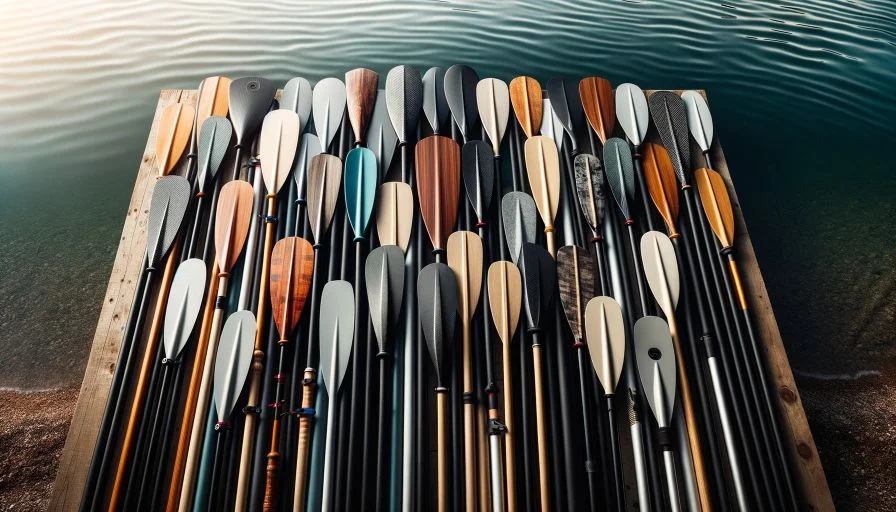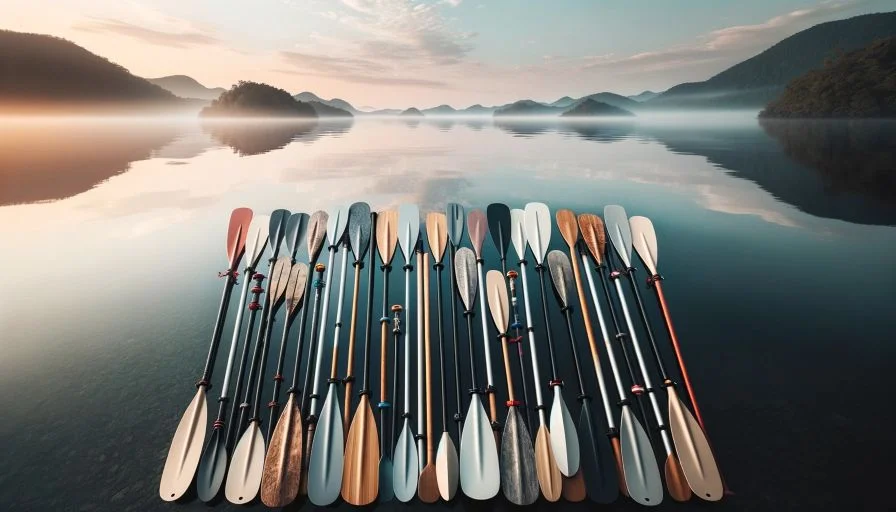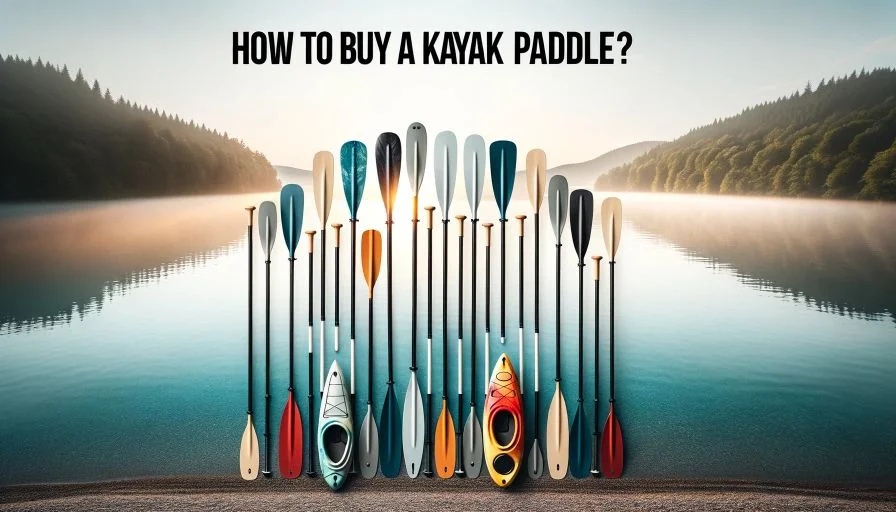When embarking on the journey of kayaking, one quickly realizes the importance of a suitable paddle. The paddle is your direct link to the water, and the choice can drastically affect your experience. To navigate the myriad of choices, it’s essential to understand how to buy a kayak paddle.
Getting Acquainted with the Basics
Understanding the Importance of Kayak Paddle Length
The length of a kayak paddle influences the comfort and efficiency of each stroke.
- Paddler Height:
- Individuals below 5’5″ might find paddles between 210-220 cm more comfortable.
- For those between 5’6″ and 6′, a range of 220-230 cm is standard.
- Paddlers above 6’1″ should consider paddles between 230-240 cm.
- Kayak Width:
- Narrow kayaks, less than 23″, often match well with shorter paddles.
- Medium width kayaks, between 24″-28″, require a slightly longer paddle.
- Wide kayaks, 29″ and above, demand the longest paddles to ensure that each stroke reaches the water without straining the paddler.
- Paddle Stroke Style:
- High-angle paddling: Involves a more vertical approach to the water, necessitating a shorter, wider paddle for quick and powerful strokes.
- Low-angle paddling: Involves a more horizontal approach, which pairs well with a longer paddle with slender blades, facilitating relaxed, longer strokes.
Materials Matter: Dive into Paddle Materials

The choice of paddle material can influence weight, durability, performance, and cost.
- Wood: Offers a nostalgic and aesthetic appeal. Wood naturally absorbs shock, providing a smooth experience. However, it requires maintenance to prevent deterioration.
- Plastic/Polypropylene: This is a beginner-friendly choice due to its affordability. It’s resilient against damage but can be heavier than other materials.
- Carbon Fiber: Praised for its lightweight properties, carbon fiber enhances paddling efficiency. It’s perfect for those looking to invest in high-end gear.
- Fiberglass: Offers a balanced combination of weight, durability, and price.
Blade Basics: Paddle Blade Size and Shape
The paddle’s blade directly interacts with the water, affecting the feel and efficiency of each stroke.
- Paddle Blade Size:
- Larger blades translate to powerful strokes, ideal for quick maneuvering or strong currents. However, they may tire the paddler faster.
- Smaller blades are energy-efficient over long distances, offering a smoother experience.
- Paddle Blade Shape:
- Wide blades provide a powerful thrust, ideal for whitewater or surf scenarios.
- Narrow blades are better suited for touring, emphasizing endurance over instant power.
Making Sense of Paddle Design and Efficiency
Various design elements can influence the paddle’s performance and the paddler’s comfort.
- Paddle Shaft Design:
- Bent Shaft: This design reduces wrist strain and fatigue by aligning the hands and wrists in a more ergonomic position.
- Straight Shaft: Traditional and versatile, these are typically lighter and less expensive than bent shafts.
- Feathered Blades: Blades set at an angle to each other reduce wind resistance, enabling smoother rotation.
- Paddle Efficiency vs. Paddle Effectiveness: Efficiency reflects the paddle’s design, ensuring that minimal energy is wasted. Effectiveness, on the other hand, evaluates how well a paddle translates your effort into movement.
Deep Dive into Advanced Considerations While Buying Kayak Paddle

Touring vs. Recreational Kayak Paddle
Your paddling purpose can dictate the best type of paddle for your needs.
- Touring Paddle: These are built for distance and sustainability. They’re typically lighter, with narrow blades for consistent, energy-efficient strokes.
- Recreational Kayak Paddle: Suited for shorter trips or casual paddling, these paddles prioritize durability and versatility.
Mastering Paddling Techniques
The way you paddle has a significant impact on the type of paddle you need.
- High-angle paddling: It demands strength and precision. The strokes are deep and powerful, best suited for maneuvering in tight spaces or tackling strong currents.
- Low-angle paddling: It emphasizes endurance. The strokes are more relaxed and spread out, ideal for long-distance touring.
The Role of Paddle Performance and Design
Understanding the nuanced differences in paddle design can enhance your paddling experience.
- Paddle Sizing: Ensuring your paddle is the right size for you and your kayak is crucial. A mismatch can lead to discomfort or inefficient paddling.
- Paddle Recommendations based on Kayak Width and Paddler Height: Use the earlier mentioned table to align your height and kayak width with the ideal paddle length.
- Paddle Measurement Guide: Always measure from your sitting position to the bridge of your nose for an accurate reading.
Detailed Considerations When Buying a Kayak Paddle
Decoding the Paddle Shaft
The paddle shaft is your direct connection to the paddle, and its design can significantly influence your paddling experience.
- Bent Shaft vs. Straight Shaft:
- Bent Shaft: The ergonomic design of bent shafts can reduce the strain on wrists, especially during long paddling sessions. It’s particularly beneficial for those with previous wrist injuries or those who are prone to fatigue.
- Straight Shaft: While they lack the ergonomic benefits of bent shafts, straight shafts are often lighter and provide a more direct feel, allowing for increased paddle control.
- Paddle Shaft Diameter:
- Smaller diameter shafts can be comfortable for paddlers with smaller hands, ensuring a firm grip.
- Standard diameter shafts are versatile and suitable for most paddlers.
The Importance of Feathered Blades
The orientation of feathered blades can influence wind resistance and the ease of paddling.
- Blade Angle: Blades can be set at different angles, ranging from 0° (unfeathered) to up to 90°. The right angle depends on personal preference and the typical wind conditions you paddle in.
- Adjustable Feathering: Some paddles offer adjustable feathering, allowing paddlers to change the blade angle depending on conditions. This feature offers versatility, especially for those who paddle in varying environments.
Exploring Paddle Performance in Depth
Delving deeper into what makes a paddle perform well can guide your purchasing decision.
- Blade Surface Area:
- A larger surface area provides more power per stroke, suitable for rapid acceleration and strong water conditions.
- A smaller surface area is efficient for long-distance paddling, conserving energy.
- Blade Profile:
- Dihedral: This is a ridge running down the center of the blade, helping reduce flutter by directing water equally off both sides of the blade.
- Flat: Lacks the central ridge and can require more control to prevent flutter, but offers a more aggressive bite in the water.
Paddle Effectiveness in Varied Conditions
Different environments and water conditions can demand different paddles.
- Whitewater Paddling: Here, durability is crucial. Whitewater paddles often feature robust materials and reinforced blades to withstand impacts with rocks.
- Sea Kayaking: Long-distance sea kayakers need efficiency. Paddles designed for this environment typically have slender blades for prolonged, efficient strokes.
Budgeting: The Paddle Price Spectrum
It’s essential to understand where your budget falls in the paddle price range and what you can expect at different price points.
- Budget-friendly Options: These are typically made of plastic or aluminum. While they’re heavier, they’re often durable and excellent for beginners.
- Mid-range Paddles: Often made from a combination of materials, like fiberglass blades with a carbon shaft. They strike a balance between performance and price.
- High-end Paddles: Made from premium materials like full carbon, they’re lightweight and optimized for performance. They’re ideal for serious kayakers or those seeking the best equipment.
Wrapping it Up with Tips and Recommendations
Ensuring the Right Fit: Paddle Sizing Revisited
While we’ve touched on paddle sizing before, it’s worth reiterating its importance. The right-sized paddle offers optimal performance, comfort, and efficiency.
- Torso Height Measurement for Paddle Size: Instead of only relying on your overall height, measuring the length of your torso can provide a more accurate paddle size recommendation.
Paddle Care and Maintenance
Investing in a paddle also means taking care of it.
- Regular Inspections: Check for cracks, especially after challenging trips.
- Cleaning: Saltwater and sand can degrade your paddle over time. Regular cleaning can prolong its lifespan.
- Storage: Store in a cool, dry place away from direct sunlight.
Closing Thoughts
Armed with this knowledge, your journey to buying the perfect kayak paddle will be informed and precise. The right paddle not only complements your style but also enhances your overall kayaking experience.
Read More:
- What Size Kayak Paddle Do I Need?
- DIY Floating Cooler for Kayak
- How to Hold a Kayak Paddle?
- How to Choose a Kayak Paddle?
- How to Size a Kayak Paddle?

Meet Hudson, an enthusiastic writer and the Chief Editor at Outdoor Bravo Blog. Hudson’s heart belongs to the world of kayaking and kayaks, fueled by his insatiable love for nature and adventure.
